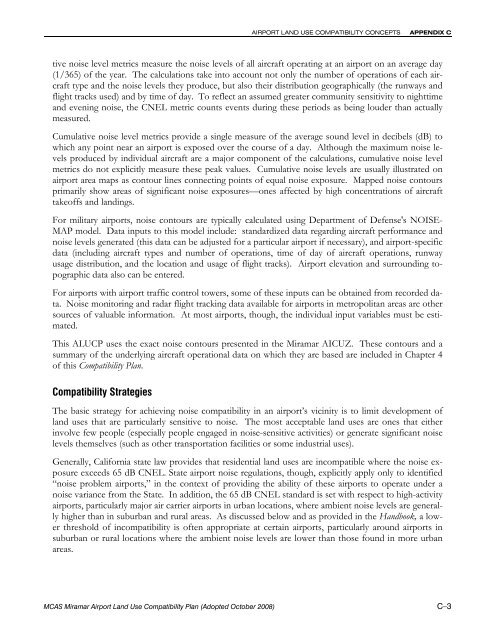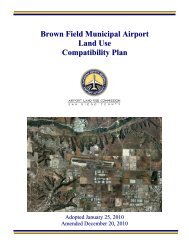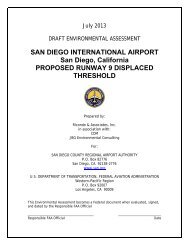MCAS Miramar Airport Land Use Compatibility Plan - San Diego ...
MCAS Miramar Airport Land Use Compatibility Plan - San Diego ...
MCAS Miramar Airport Land Use Compatibility Plan - San Diego ...
Create successful ePaper yourself
Turn your PDF publications into a flip-book with our unique Google optimized e-Paper software.
AIRPORT LAND USE COMPATIBILITY CONCEPTSAPPENDIX Ctive noise level metrics measure the noise levels of all aircraft operating at an airport on an average day(1/365) of the year. The calculations take into account not only the number of operations of each aircrafttype and the noise levels they produce, but also their distribution geographically (the runways andflight tracks used) and by time of day. To reflect an assumed greater community sensitivity to nighttimeand evening noise, the CNEL metric counts events during these periods as being louder than actuallymeasured.Cumulative noise level metrics provide a single measure of the average sound level in decibels (dB) towhich any point near an airport is exposed over the course of a day. Although the maximum noise levelsproduced by individual aircraft are a major component of the calculations, cumulative noise levelmetrics do not explicitly measure these peak values. Cumulative noise levels are usually illustrated onairport area maps as contour lines connecting points of equal noise exposure. Mapped noise contoursprimarily show areas of significant noise exposures—ones affected by high concentrations of aircrafttakeoffs and landings.For military airports, noise contours are typically calculated using Department of Defense's NOISE-MAP model. Data inputs to this model include: standardized data regarding aircraft performance andnoise levels generated (this data can be adjusted for a particular airport if necessary), and airport-specificdata (including aircraft types and number of operations, time of day of aircraft operations, runwayusage distribution, and the location and usage of flight tracks). <strong>Airport</strong> elevation and surrounding topographicdata also can be entered.For airports with airport traffic control towers, some of these inputs can be obtained from recorded data.Noise monitoring and radar flight tracking data available for airports in metropolitan areas are othersources of valuable information. At most airports, though, the individual input variables must be estimated.This ALUCP uses the exact noise contours presented in the <strong>Miramar</strong> AICUZ. These contours and asummary of the underlying aircraft operational data on which they are based are included in Chapter 4of this <strong>Compatibility</strong> <strong>Plan</strong>.<strong>Compatibility</strong> StrategiesThe basic strategy for achieving noise compatibility in an airport’s vicinity is to limit development ofland uses that are particularly sensitive to noise. The most acceptable land uses are ones that eitherinvolve few people (especially people engaged in noise-sensitive activities) or generate significant noiselevels themselves (such as other transportation facilities or some industrial uses).Generally, California state law provides that residential land uses are incompatible where the noise exposureexceeds 65 dB CNEL. State airport noise regulations, though, explicitly apply only to identified“noise problem airports,” in the context of providing the ability of these airports to operate under anoise variance from the State. In addition, the 65 dB CNEL standard is set with respect to high-activityairports, particularly major air carrier airports in urban locations, where ambient noise levels are generallyhigher than in suburban and rural areas. As discussed below and as provided in the Handbook, a lowerthreshold of incompatibility is often appropriate at certain airports, particularly around airports insuburban or rural locations where the ambient noise levels are lower than those found in more urbanareas.<strong>MCAS</strong> <strong>Miramar</strong> <strong>Airport</strong> <strong>Land</strong> <strong>Use</strong> <strong>Compatibility</strong> <strong>Plan</strong> (Adopted October 2008) C–3
















